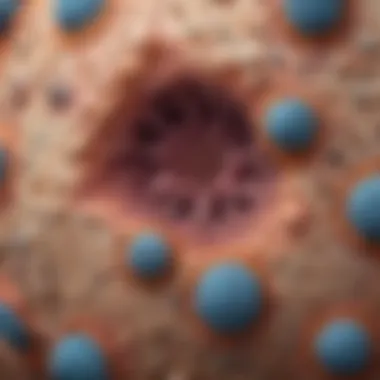SCC vs BCC: Understanding Skin Cancer Differences


Intro
Skin cancer is a complex topic in the realm of oncology, with squamous cell carcinoma (SCC) and basal cell carcinoma (BCC) representing two of the most common forms. Each type has its distinct characteristics, pathophysiology, and treatment methods. Understanding the nuanced differences between SCC and BCC is crucial not only for patients but also for healthcare providers and researchers alike. This article provides an extensive analysis on their unique aspects, creating a well-rounded resource that addresses the key elements that define each type of skin cancer.
The information discussed here aims to shed light on the risk factors, particular clinical presentations, and treatment protocols for both SCC and BCC. By identifying these factors, we can better appreciate the implications for patient care and the studies that guide treatment decisions.
Foreword to Skin Cancers
Skin cancer is a significant area of concern in modern medicine. Understanding skin cancers equips both healthcare providers and patients with the knowledge necessary for prevention, early detection, and treatment. This section will address key elements related to skin cancer, specifically focusing on squamous cell carcinoma (SCC) and basal cell carcinoma (BCC), which are the two most common types.
The impact of skin cancer extends beyond physical health. It also encompasses psychological and social consequences. Early education about these cancers can lead to better outcomes for those affected. Knowing the risk factors, symptoms, and the importance of regular dermatological check-ups can save lives.
Understanding Skin Anatomy
To comprehend skin cancers, one should first understand skin anatomy. The skin is the largest organ of the human body and serves several essential functions. It acts as a barrier, protects against pathogens, and regulates temperature. The skin has three main layers:
- Epidermis: The outermost layer, which contains skin cells that continually shed and regenerate. It is here where the majority of skin cancers, including SCC and BCC, originate.
- Dermis: Located beneath the epidermis, this layer contains blood vessels, nerves, and connective tissue. It provides support and nourishment to the epidermis.
- Hypodermis: This is the deepest layer, consisting primarily of fat and connective tissue. It serves as insulation and energy storage.
Understanding these layers is crucial. Certain skin cancers arise in specific layers, influencing treatment decisions and prognoses.
Defining Skin Cancer
Skin cancer is characterized by the abnormal growth of skin cells. Most often, this abnormal growth is triggered by excessive sun exposure, although genetic predisposition and environmental factors play crucial roles. Skin cancers are generally categorized into two groups: non-melanoma and melanoma.
Non-melanoma skin cancers, which include SCC and BCC, are more common but typically less aggressive than melanoma. They tend to have lower mortality rates but can still lead to significant morbidity.
Skin cancer can present in various forms, and accurate diagnosis is imperative for effective treatment. Recognizing the signs, such as a new growth or a sore that does not heal, is key to early intervention.
"An early diagnosis can dramatically increase survival outcomes in skin cancer cases."
Both squamous cell carcinoma and basal cell carcinoma require distinct approaches to management. Therefore, understanding their differences and similarities is essential in both clinical and educational settings. By delving deeper into these cancers, this article aims to provide a wealth of information that can inform and guide future actions in oncology.
Types of Skin Cancer
Understanding the types of skin cancer is crucial for comprehending the scope and impact of this disease on public health. Skin cancers are broadly categorized into melanoma and non-melanoma types, of which squamous cell carcinoma (SCC) and basal cell carcinoma (BCC) are the most common. The distinction between these types is not merely academic; it informs prevention strategies, early detection methods, and treatment protocols.
Recognizing the differences among these cancers enables both healthcare professionals and the public to address risk factors more effectively. Moreover, studying the various characteristics of skin cancers can lead to enhanced understanding of treatment outcomes and survival rates, ultimately benefiting those affected by these diseases.
Overview of Non-Melanoma Skin Cancers
Non-melanoma skin cancers, primarily comprising basal cell carcinoma and squamous cell carcinoma, represent the majority of skin cancer diagnoses worldwide. These cancers originate from different layers of skin tissue.
- Basal Cell Carcinoma: This type develops from the basal cells in the epidermis. It tends to grow slowly and rarely metastasizes.
- Squamous Cell Carcinoma: Arising from squamous cells, this variant may appear more aggressive, and has a higher chance of spreading if left untreated.
While non-melanoma cancers are less deadly compared to melanoma, they can significantly affect a person's quality of life through disfigurement and recurrent treatment needs. Understanding the prevalence and behavior of non-melanoma skin cancers is essential for developing effective public health interventions, including education about sun protection and skin examination practices.
Classification of Skin Cancers
Skin cancers are classified based on their histological characteristics, origin, and behavior. The classifications help in determining the appropriate diagnostic and treatment approaches.


- Primary Skin Cancers: This category involves cancers originating from skin cells, including BCC, SCC, and melanoma.
- Secondary Skin Cancers: Resulting from metastasis, these cancers spread from other organs to the skin.
The classification aids in understanding the growth patterns.
Squamous Cell Carcinoma
Squamous Cell Carcinoma (SCC) represents a critical topic within the broader discourse on skin cancers. This form of cancer arises from the squamous cells, which are flat cells found in the outer layer of skin. Understanding SCC is paramount due to its potential for aggressive behavior and the varying outcomes associated with its management.
SCC predominantly affects areas of the skin that have been frequently exposed to sunlight. Its growth can be rapid, leading to local destruction of tissues if not addressed promptly. The importance of this discussion lies in the distinction between SCC and other skin cancers, particularly its differences in etiology, risk factors, and treatment landscape.
Healthcare professionals must be particularly vigilant, as early detection significantly enhances treatment success and patient prognosis. Therefore, a thorough analysis of SCC can provide valuable insights for researchers and practitioners hunting for effective strategies tailored to combat this form of cancer.
Pathophysiology of SCC
The pathophysiology of SCC involves a complex interaction of genetic, environmental, and immunologic factors. The cancer commonly arises from cumulative sun exposure, resulting in DNA damage to the skin cells. Mutations in genes that control cellular processes, such as keratinization, lead to the unregulated proliferation of squamous cells.
Ultraviolet radiation is a significant contributor to this damage. Additionally, chronic inflammation and exposure to carcinogenic substances like tobacco also play pivotal roles in SCC development. The understanding of these mechanisms is vital, as it opens avenues for targeted interventions and preventive strategies.
Risk Factors for SCC
Several risk factors contribute to the likelihood of developing SCC. These include:
- Chronic Sun Exposure: Direct exposure to sunlight can lead to skin damage over time.
- Fair Skin: Individuals with lighter skin are at a higher risk.
- Immunosuppression: Conditions that weaken the immune system increase susceptibility.
- Previous Skin Cancers: A history of BCC or SCC raises the risk of recurrence.
- Exposure to Carcinogens: These include chemicals found in various occupational environments.
Awareness of these risk factors encourages preventative measures, such as using sunscreen and engaging in regular dermatological check-ups.
Clinical Presentation and Symptoms of SCC
SCC may present with a variety of clinical features depending on its location and depth of invasion. Common manifestations include:
- A Persistent Wound or Ulcer: This can appear crusted or scaly and does not heal.
- Raised, Red, Scaly Lesions: These lesions are often located on sun-exposed areas.
- Tenderness or Pain: As SCC progresses, discomfort in the affected area may occur.
Understanding these symptoms is essential for healthcare practitioners as timely recognition is crucial for effective management.
Diagnosis of SCC
Diagnosing SCC typically relies on clinical examination and histopathological analysis. A dermatologist usually inspects the skin and, if SCC is suspected, a biopsy is performed to confirm the diagnosis. The biopsy specimen is examined under a microscope to identify characteristic features of SCC. Further imaging studies may be needed to assess the extent of disease spread, particularly if metastasis is suspected.
Treatment Options for SCC
Treatment modalities for SCC are diverse and depend on various factors including tumor size, location, and detection stage. Common treatment options include:
- Surgical Excision: Complete removal of the tumor is often the first-line approach.
- Mohs Micrographic Surgery: A specialized technique that removes cancerous cells layer by layer, preserving healthy tissue.
- Radiation Therapy: Used primarily for non-surgical candidates or recurrent SCC.
- Topical Chemotherapy: Medications applied directly to superficial SCCs.
A multi-disciplinary approach often provides the best outcomes, considering the involvement of oncologists, dermatologists, and surgical teams in the treatment process.
Prognosis of SCC
The prognosis for SCC largely depends on the tumor's stage, size, and location. Early-stage tumors generally have a favorable outcome, often curable with surgical intervention. However, larger or more invasive SCCs can have a higher risk of metastasis, especially to regional lymph nodes. Educating patients about self-examinations and the importance of follow-ups is crucial to monitor for recurrence.


In summary, understanding SCC's pathophysiology, risk factors, and prognosis is vital for effective management and patient education. Furthermore, awareness of the clinical presentation and treatment options empowers both patients and practitioners in their approach to care.
Basal Cell Carcinoma
Basal cell carcinoma (BCC) is significant due to its status as the most common form of skin cancer worldwide. Understanding BCC is crucial as it varies from other skin cancers in many ways. This analysis will delve into its pathophysiology, risk factors, symptoms, diagnosis, treatment options, and prognosis. Each of these elements contributes to a comprehensive view of BCC, which is essential for both prevention and treatment in clinical practice.
Pathophysiology of BCC
BCC arises from basal cells in the epidermis. These cells are responsible for producing new skin cells as old ones die off. One primary feature of BCC is its abnormal growth rate, which can be influenced by various factors. BCC often results from long-term exposure to ultraviolet (UV) radiation, which damages the DNA in skin cells, leading to mutations. Unlike squamous cell carcinoma, BCC rarely metastasizes. However, its growth can cause significant local damage and distortions in appearance.
Risk Factors for BCC
Several factors can increase the likelihood of developing BCC. These include:
- UV Exposure: Frequent tanning, especially indoor tanning, greatly raises risk.
- Skin Type: Individuals with light skin, light hair, and blue or green eyes are more vulnerable.
- Age: Older adults have a higher incidence due to cumulative sun exposure.
- Immune Suppression: Those with weakened immune systems are at increased risk.
- Previous Skin Cancers: A history of BCC or other skin cancers raises the likelihood of recurrence. Understanding these risk factors can inform prevention strategies and screening practices.
Clinical Presentation and Symptoms of BCC
The presentation of BCC can vary significantly, though there are common signs and symptoms to look for:
- Pearly Bumps: Typical BCC appears as small, shiny, pearly bumps on the skin, often on areas exposed to sunlight.
- Open Sores: These may not heal or may heal and return.
- Red Patches: Flat, red patches can occur, often mistaken for eczema.
- Scar-Like Area: A white, waxy area resembling a scar may also appear. Identifying these early signs is vital for timely intervention and treatment.
Diagnosis of BCC
Diagnosing BCC typically requires a thorough examination by a dermatologist. This may involve:
- Visual Inspection: The doctor examines the skin for characteristic signs.
- Biopsy: A tissue sample is taken to confirm the diagnosis.
- Dermatoscopy: This technique uses a special magnifying device to enhance visual assessment.
Proper diagnosis ensures accurate treatment planning and improves patient outcomes.
Treatment Options for BCC
Treatment approaches for BCC depend on factors such as size, location, and patient preference. Common treatments include:
- Surgical Excision: The most common method involves removing the cancerous tissue.
- Mohs Micrographic Surgery: This method removes BCC layer by layer, minimizing damage to surrounding skin.
- Topical Chemotherapy: Medications like imiquimod can be applied directly on small lesions.
- Radiation Therapy: Often used for patients who cannot undergo surgery. Choosing the right treatment regimen is essential for effective management and relapse prevention.
Prognosis of BCC
The prognosis for individuals diagnosed with BCC is generally favorable. Most cases are successfully treated, with a low rate of metastasis. However, recurrent cases can occur, particularly if not entirely removed during the initial treatment. Factors influencing prognosis include the tumor's size, location, and aggressiveness. Regular follow-ups are essential for monitoring potential recurrence over time.
"Basal cell carcinoma is typically non-life-threatening, but early detection and treatment are crucial to prevent complications and ensure a good prognosis."
Understanding BCC helps health professionals provide better care and guides patients in making informed decisions regarding their health. This knowledge is vital in a landscape where skin cancers are increasingly prevalent, and timely intervention can significantly alter outcomes.
Comparative Analysis: SCC vs BCC
The comparative analysis of squamous cell carcinoma (SCC) and basal cell carcinoma (BCC) is pivotal for multiple reasons. Both are the most common forms of skin cancer, yet their behavior, treatment, and outcomes differ significantly. Understanding these differences can inform both clinical practices and patient management strategies.
Healthcare professionals can tailor their approaches based on the specific characteristics of each type. For researchers, this analysis highlights potential areas for future studies. The practical implications of comparing these two cancers make it essential for educational purposes as well.
In addition, distinguishing between SCC and BCC can aid in risk assessment and early detection, which are critical for effective intervention.


Histological Differences
The histological features of SCC and BCC reveal distinct cellular characteristics.
- SCC originates from keratinocytes, which are the primary cell types in the outer layer of skin. It showcases atypical keratinization, which manifests in irregularly shaped cells with thickened keratin layers.
- BCC, on the other hand, arises from the basal layer of the epidermis. Histologically, BCC is characterized by nests of basaloid cells, which appear tightly packed, leading to a distinct "peripheral palisading" effect.
Understanding these cellular differences is vital. These characteristics not only guide pathologists in diagnosis but also inform potential therapeutic targets.
Differences in Incidence and Prevalence
SCC and BCC demonstrate differing incidences and prevalence in various populations.
- SCC incidence is influenced significantly by cumulative sun exposure, particularly in fair-skinned individuals. In the United States, SCC accounts for about 20% of non-melanoma skin cancers, showing a rising trend due to increased UV exposure.
- BCC is even more prevalent, constituting approximately 75% of non-melanoma cases. Its occurrence is also closely related to sun exposure but can be influenced by other factors such as genetics and immunosuppression.
The geographical variation in their incidence highlights the role of environmental factors and underscores the need for localized prevention strategies.
Metastasis Potential
The metastatic potential is another defining aspect.
- SCC is considered more aggressive and has a higher likelihood of metastasis compared to BCC. Metastatic SCC can spread to regional lymph nodes and even distant organs if not addressed early.
- Conversely, BCC rarely metastasizes. It primarily presents as a locally invasive tumor, which, while destructive to surrounding tissues, does not typically invade other parts of the body.
This difference significantly impacts treatment decisions and patient prognosis.
Treatment Efficacy
The treatment approaches for each carcinoma type also reflect their differences.
- Common treatments for SCC include surgical excision, Mohs micrographic surgery, and sometimes radiation therapy. The choice of treatment often depends on tumor size, location, and depth of invasion.
- BCC treatment is predominantly surgical as well, with options including cryotherapy and topical chemotherapy for superficial cases. Mohs surgery is beneficial here too, particularly for large or recurrent tumors.
The efficacy of treatments can vary significantly, highlighting the importance of accurate diagnosis and individualized treatment plans.
The differences between SCC and BCC in histology, prevalence, metastasis potential, and treatment options underscore the necessity of comprehensive clinical understanding and targeted interventions.
Epilogue and Future Directions
In examining the comparative aspects of squamous cell carcinoma (SCC) and basal cell carcinoma (BCC), this article highlights several critical elements relevant to both clinicians and researchers. Understanding the unique features of each cancer type, including their pathophysiology, risk factors, clinical presentations, and treatment options, is paramount in improving patient outcomes.
In terms of benefits, recognizing how SCC and BCC differ assists in tailoring treatment strategies. SCC, with its higher metastasis potential, demands a more aggressive approach, whereas BCC, generally less aggressive, may require less intensive management. Proper understanding influences overall health care decisions, impacting early detection and patient education.
Considerations about future directions involve ongoing research into the molecular underpinnings of both cancers. Detailed studies on genetic factors, environmental influences, and stromal interactions could yield significant insights.
Summary of Key Insights
The discussion surrounding SCC and BCC provides key insights pivotal for medical practice. Notable points include:
- Differences in Pathophysiology: SCC arises from keratinocytes, while BCC originates from basal cells.
- Incidence and Prevalence: BCC is the most frequently diagnosed skin cancer, notably more common than SCC.
- Metastatic Potential: SCC poses a higher risk of metastasis compared to the localized nature of BCC.
- Treatment Efficacy: Treatment responses vary, necessitating a tailored approach for effective management.
Each of these elements invites deeper exploration, which can lead to improved therapies and preventive strategies.
Implications for Research and Treatment
The implications for ongoing research and treatment are manifold. Research initiatives should focus on:
- Early Detection: Exploring advanced imaging techniques to better identify both SCC and BCC.
- Genomic Studies: Investigating genetic predispositions that could indicate susceptibility to developing these skin cancers.
- Novel Therapeutics: Evaluating new drug options that could enhance existing treatment modalities, particularly for aggressive SCC.
- Patient Education: Enhancing public awareness regarding risk factors and the importance of sun protection could reduce incidence rates.
This exploration into SCC and BCC not only emphasizes existing knowledge but also opens avenues for future inquiries that may significantly alter treatment landscapes. Understanding these cancers is critical as the global incidence of skin cancer continues to rise, making ongoing research imperative for better health outcomes.













